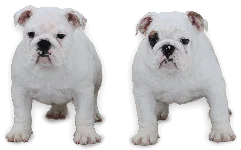What is Tracking?
How a Tracking Test Works
For the host club and the two judges, a tracking test is a two-day commitment, regardless of weather. Tracking tests are usually held on Sunday, but the judges and tracklayers spend most of Saturday plotting a track for each dog. The judges draw charts of each track indicating landmarks that will allow them to locate the track with flags that mark the turns. The flags will be removed when the tracklayers walk the track the morning of the test. On the morning of the test, the exhibitors gather for a “draw,” which determines the order dogs are to exhibit. After the tracks have aged the required time, the exhibitor puts the harness on the dog, attaches a 20-to-40-foot lead and begins the track. The dog is not allowed off lead at any time. The dog must follow the path the tracklayer has walked and find the article(s) dropped along the track. Judges follow the dog and handler to determine if the dog is on or off the track. If the dog is off the track and the judges determine the dog cannot return, one judge will blow the whistle signaling the dog has failed. There is no time limit as long as the dog is working. If the dog follows the track and finds the article(s) placed on the track, he earns the tracking title for the level at which he is exhibiting.
The TD track is from 440-to-500 yards long with 3-to-5 turns (or change in direction), and aged from a half-hour to two hours. A dog must indicate a glove or wallet placed at the end of the track. Tracks are plotted in an open field with uniform cover. There are no obstacles. The start of the track will be marked with a flag. A second flag is placed 30 yards from the start flag to indicate the direction of the first leg of the track. There are no other flags in the field.
The TDX track is 800-to-1000 yards long with 5-to-7 turns, and aged from 3-to-5 hours. The track also has two sets of cross (diversionary) tracks and has some of the aforementioned obstacles. The start is marked with a single flag and the dog must determine the direction of the first leg. There are four dissimilar articles for each track, one at the start and three more on the track.
The TDU track is 400-to-5oo yards long, with 3-to-5 90 degree turns, and aged from a half-hour to two hours. Tracks are plotted in an urban environment on paved sidewalks, lightly traveled roads, baseball diamonds, parking lots and other non-vegetated surfaces. The track will have a minimum of two (2) different surfaces, vegetated and non-vegetated. The start is marked with a flag with a second flag set 30 yards from the first to indicate the direction of the first leg of the track. There are three dissimilar articles for each track, one at the start, one about midway on the track and one at the end.
A VST track is from 600-to-800 yards long, with 4-to-8 turns, and aged from 3-to-5 hours. The articles must be one each of leather, cloth, plastic and metal. The VST track must also contain three different surfaces with one turn on a non-vegetated surface such as concrete. This test demonstrates the utility of the tracking dog to work in an urban environment.












